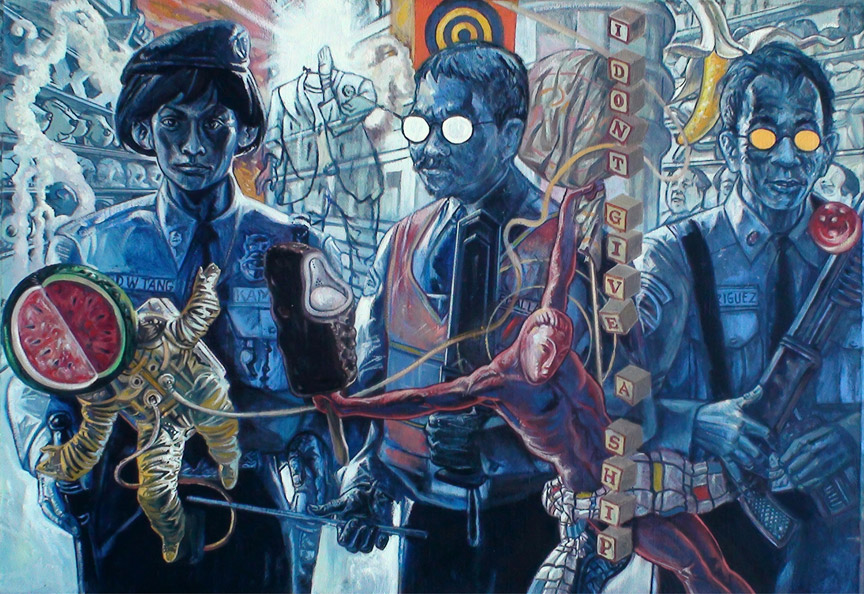Shows
“Intersecting Histories: Contemporary Turns in Southeast Asian Art”


A glass-wrapped atrium fronts the street where the viewer encounters a sculptural figure, imprisoned in a ring of metal bars and donning a jacket embroidered with words that read, “Don’t give money to the arts.” The figure reaches out, as if in supplication, to a larger-than-life sketch of former Singapore president Ong Teng Cheong. The work commemorates a significant point in the local history of art. In 1995, Tang Da Wu—a founding member of the pioneering Artists Village collective—had approached Ong in public, clad in that very jacket, and handed him a note that read, “I am an artist. I am important.”
“Intersecting Histories: Contemporary Turns in Southeast Asian Art” inaugurated the newly reopened gallery at Nanyang Technological University’s School of Art, Design and Media. Curated by one of Singapore’s most prolific art historians, TK Sabapathy, the show foregrounded the trajectories of postwar art in the region, charting the various cross-currents—social, political and aesthetic—that yoke the post-colonial polities of Southeast Asia. More vitally, the show reclaimed the history of its objects; history once fraught with ideological contention, but now neglected by a largely market-oriented art infrastructure. Tang’s installation, Don’t Give Money to the Arts (1995/2012), was positioned at the building’s main entrance and provided an apposite introduction. Tang’s renown as a seminal figure is endorsed by Ho Tzu Nyen’s video 4x4 - Episodes of Singapore Art: Episode 3 - Tang Da Wu, The Most Radical Gesture (2005), which is displayed in the same gallery. The work, first shown on public television, holds up Tang’s interventionist performance as “the most radical gesture,” emplotting it as one of four privileged moments in the narrative of Singapore art (its account, for all intents and purposes, legitimized by mass dissemination through official channels.) This verdict is echoed by Filipino artist Jose Tence Ruiz’s aptly titled The Pro-rated Wage of the Abang Guard (2011). Alongside Tang, the painting depicts Ruiz’s countrymen, artists David Medalla and Roberto Chabet, as icons and keepers of the canon, evoking a shared sense of art and art historiography.

The rise of conceptual art in Southeast Asia was well attested to in the show. Cheo Chai Hiang, another groundbreaking figure, was represented by his 1976 piece, And Miles To Go Before I Sleep. Comprised of a wooden washboard hinged to a log, the work is inscribed with a titular refrain borrowed from Robert Frost’s poem, Stopping by Woods on a Snowy Evening. The work plays with slippages between high art and the found object, and between visual and verbal texts. Cheo is best known for Singapore River (1972), which consists solely of directions to draw a square at the juncture between a wall and the ground. It was mailed in to an art show (and rejected), and is often cited as one of the earliest examples of indigenous conceptualism. Elsewhere in the exhibition, Redza Piyadasa’s May 13, 1969 (1969/2001) utilizes the language of conceptual art as a tool for interrogating issues of socio-historical urgency. A coffin-shaped receptacle is painted with the colors of the Malaysian flag, and positioned upright on a mirror. The date is a reference to the cataclysmic racial riots of the late 1960s, which led to a suspension of parliament and the declaration of a state of emergency in Malaysia. The sarcophagus embodies the nation and the body politic; as if in a gesture of mourning for his country, Piyadasa incinerated the original work in a bonfire shortly after its completion, recreating it only in 2001.
In tandem with the emergence of the body as a site of broader theoretical interest in recent decades, the human form was prominently displayed. At opposite ends of the gallery were two seemingly antithetical figures. Julie Lluch’s Thinking Nude (1988) is a naturalistic representation of a naked woman, poised before a mirror—her meditative expression seeming to contemplate her exposed breasts and the pronounced scars on her abdomen, which appear to be the marks of a caesarian procedure. While the work is, according to Lluch, “a statement on a woman’s growing knowledge of selfhood and sexuality,” it perhaps less directly implicates the culture of control over women’s bodies in the piously Catholic Philippines, Lluch’s native country, where abortion is still outlawed. Lang Kacang (1991), by Malaysian artist Bayu Utomo, on the other hand, assembles the human anatomy from fragments of industrial materials: metal sheets, chains, cement casts. The armless figure, which evokes the legendary Iban warrior of its title, tilts its head up and its torso forwards, its mouth open in a soundless shriek of warlike bellicosity or—not unlike Munch’s The Scream—existential trauma. In either case, its expression of anguish, and its limbless impotence, stands as a response to the conditions of capitalist modernity facing Malaysia’s tribal communities.
One of the show’s weak spots was the dearth of work from Thailand. The neglect of abstract traditions in Southeast Asia, an overlooked genre, is also regrettable. Beyond those limitations, however, “Intersecting Histories” proved to be a canny, timely contribution to regional art scholarship, excavating otherwise forgotten narratives.







